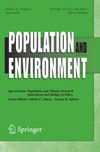-
State of Population-Climate Change Research
May 1, 2014 By Paris Achenbach What is the future of population and climate change research, and how can this research impact international policy? In a special issue of Population and Environment, environmental and social scientists look at these questions. “One of the most exciting developments in the climate change research community at present is the development of a new generation of climate scenarios,” write Adrian C. Hayes and Susana B. Adamo in the introduction. These can help facilitate more interdisciplinary research.
What is the future of population and climate change research, and how can this research impact international policy? In a special issue of Population and Environment, environmental and social scientists look at these questions. “One of the most exciting developments in the climate change research community at present is the development of a new generation of climate scenarios,” write Adrian C. Hayes and Susana B. Adamo in the introduction. These can help facilitate more interdisciplinary research.Lori Hunter and Brian O’Neill, for example, discuss “shared socio-economic pathways” (SSPs), a new framework that expands on the IPCC’s Special Report on Emissions Scenarios and combines demographic, socio-economic, and environmental models to identify gaps in population-environment research and to pose “plausible alternative trends in the evolution of social and natural systems over the twenty-first century.” The five core representative pathways outlined are 1) sustainability, in which the world shifts gradually but dramatically toward a more sustainable path; 2) middle of the road, in which global population growth is moderate and development and income growth proceeds unevenly; 3) fragmentation, in which countries increasingly focus on domestic issues instead of broader-based development; 4) inequality, in which vulnerable groups have little representation in national and global institutions, and the world is regularly in social conflict; and 5) conventional development, where the world continues to be driven by the economic success of industrialized economies and adopts energy-intensive lifestyles. The authors emphasize that the SSP framework is open for further revision, and that researchers must continue to study and develop them.
Despite the recognition that physical and social changes in ecosystems need to be understood together, only “a small portion of the vulnerability literature to date has explicitly focused on population age, distribution, and location as central exposure elements at a continental scale,” write David Lopez-Carr et al. in a spatial analysis of climate changes. Their paper specifically examines changes in Africa, which they write is the most vulnerable region to long-term decreases in rainfall and seasonal rainfall variability and where over 95 percent of the farmers subsist on rain-fed land. The authors identify “vulnerability hot spots,” where populations are increasing as precipitation is decreasing. Lake Victoria Basin emerges as one of the most significant, where 40 million people rely on land that is increasingly exposed to drought, water shortages, and food insecurity. Vulnerability is further exacerbated by changes in disease prevalence, such as malaria. This kind of integrated research has been “limited by the disciplinary gap between climate scientists and social scientists,” the authors write. “Our integrated data at a continental scale is relatively rare today, but we believe that it represents the future of integrated geographical, climate, environmental, and sociological research.”
The full special issue is worth a read.
Sources: Population and Environment.
Topics: adaptation, Africa, agriculture, climate change, conflict, demography, development, environment, food security, Kenya, land, population, Reading Radar, research, security, Tanzania, Uganda, water
 A Publication of the Stimson Center.
A Publication of the Stimson Center.




